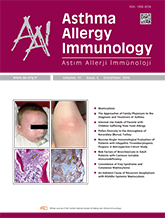


Objective: Primary Immune Thrombocytopenia (ITP, idiopathic thrombocytopenic purpura, immune thrombocytopenic purpura) is an acquired thrombocytopenia caused by anti-platelet antibodies. The diagnosis of ITP may be challenging due to the various potential causes of thrombocytopenia, some of which are overlooked. Immunodeficiencies are also a rare cause of ITP. Although autoimmunity and, therefore, ITP are a common complication in primary immunodeficiency (PI) patients, there are not many publications in the literature that examine the frequency of PI in ITP patients and the immune abnormalities in these patients.
Materials and Methods: Forty-five patients with ITP (F: 37 [78.7%], M: 10 [21.3%]) were included in the study (age 42.9 ± 15.9).
Results: At least one antibody deficiency was detected in 7 patients (14.9%), and following further investigations, 2 patients (4.3%) were diagnosed with CVID, 3 (6.4%) with IgG deficiency, 1 (2.1%) with selective IgA deficiency and 1 (2.1%) with possible IgM deficiency. Immunoglobulin levels were normal while at least one abnormality was detected in 20 patients (42.6%) in peripheral lymphocyte subset analyses. The most common abnormality in this patient group was a reduced percentage of CD4+ T-cells (9 patients, 45% of patients with PLS abnormalities, 19.1% of all patients). CD3+ T-cell rates in 8 patients (17.8%), CD19+ B-cell rates in 6 (12.8%), CD3-CD16+56+ natural killer cell rates in 4 (8.5%), and CD4/CD8 cell ratios in 7 (14.9%) were reduced. In addition, the CD8+ T-cell rate in 8 patients (17%) was above the reference ranges.
Conclusion: Adult patients who are diagnosed with ITP may develop a variety of immunological abnormalities in addition to hypogammaglobulinemia. Therefore, clinicians should not overlook immunological evaluation in the etiological investigation of ITP and should closely monitor patients with immunological abnormalities.